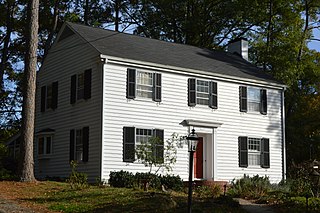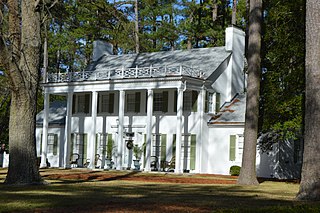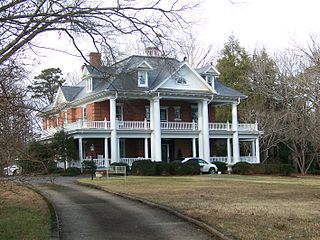
Halifax Historic District is a national historic district located at Halifax, Halifax County, North Carolina, US that was listed on the National Register of Historic Places in 1970 with an increase in 2011. It includes several buildings that are individually listed on the National Register. Halifax was the site of the signing of the Halifax Resolves on April 12, 1776, a set of resolutions of the North Carolina Provincial Congress which led to the United States Declaration of Independence gaining the support of North Carolina's delegates to the Second Continental Congress in that year.

Downtown Asheville Historic District is a national historic district located at Asheville, Buncombe County, North Carolina. The district encompasses about 279 contributing buildings and one contributing object in the central business district of Asheville. It includes commercial, institutional, and residential buildings in a variety of popular architectural styles including Colonial Revival, Queen Anne, and Art Deco.

Central Shelby Historic District is a national historic district located at Shelby, Cleveland County, North Carolina. It encompasses 229 contributing buildings in the central business district and surrounding residential areas of Shelby. The district is centered on the Cleveland County Courthouse (1907) and public square, established in 1841. The district includes representative examples of Colonial Revival and Bungalow / American Craftsman architectural styles. The district includes the separately listed courthouse, Masonic Temple Building, and Webbley. Other notable buildings include the Webb House, Wells House, Fulenwider-Ebeltoft House, Dr. S. S. Royster House, Bateman House, Washburn Block, city hall and firehouse (1911), Royster Building (1910), First Baptist Church, Ascension Lutheran Church (1932), and Southern Railway Freight Depot.

Haymount District, also known as Haymount Historic District, is a national historic district located at Fayetteville, Cumberland County, North Carolina. It encompasses 60 contributing buildings and 1 contributing site in a primarily residential section of Fayetteville. The dwellings were built between about 1817 and 1950, and include notable examples of Queen Anne and Colonial Revival style architecture. The earliest extant residence is the Robert Strange Town House, home of Senator Robert Strange (1796-1854). Another notable building is the Highsmith Memorial Hospital, designed by architect Charles C. Hartmann and completed in 1926. Also located in the district is the separately listed Edgar Allan Poe House.

Morehead Hill Historic District is a national historic district located at Durham, Durham County, North Carolina. The district encompasses 206 contributing buildings in a predominantly residential section of Durham. They were built between the late-19th century and 1950s and include notable examples of Late Victorian, Queen Anne, and Bungalow / American Craftsman style architecture.

Trinity Historic District, also called Trinity Park, is a national historic district and residential area located near the East Campus of Duke University in Durham, North Carolina. The district encompasses 751 contributing buildings in a predominantly residential section of Durham. They were built between the 1890s and 1960 and include notable examples of Queen Anne and Bungalow / American Craftsman style architecture. Located in the district are the separately listed "Faculty Row" cottage: the Bassett House, Cranford-Wannamaker House, Crowell House, and Pegram House. Other notable buildings include the George W. Watts School (1917), Julian S. Carr Junior High School (1922), Durham High School (1923), Durham Alliance Church (1927), Trinity Presbyterian Church (1925), Great A & P Tea Company (1927-1929), Grace Lutheran Church, and the former Greek Orthodox Community Church.

Rocky Mount Central City Historic District is a national historic district located at Rocky Mount, Edgecombe County and Nash County, North Carolina. The district encompasses 166 contributing buildings in central Rocky Mount. It includes a variety of industrial, commercial, residential, and institutional buildings dating from the late-19th through mid-20th centuries. Notable buildings include the Firestation No. 2 (1924), Union Bus Station (1951), the Railway Express Agency Building, Memorial Hospital (1937), Church of the Good Shepherd (1877), Atlantic Coastline Railroad Station (1903-1916), Imperial Tobacco Company Processing Plant (1903-1923), S. H. Kress and Company, Belk-Tyler, Grand Theater, Manhattan Theater, Holy Hope Episcopal Church (1910s), and Summerlin House (1895).

Snow Hill Historic District is a national historic district located at Snow Hill, Greene County, North Carolina. The district encompasses 229 contributing buildings, a contributing site, two contributing structures, and a contributing object in the central business district and surrounding residential sections of Snow Hill. The buildings are in a variety of popular 19th and early-20th century architectural styles including Greek Revival, Gothic Revival, Colonial Revival, and, Bungalow / American Craftsman. Located in the district are the separately listed Greene County Courthouse and St. Barnabas Episcopal Church. Other notable buildings include J. Exum & Co. Grocery building, Harper Drugstore, Sugg-Harper House, Williams-Exum Housem, Murphrey-Morrill House (1885), Josiah Exum House (1887-1888), Alfred Warren House (1912-1915), Calvary Memorial Methodist Church (1928), Snow Hill Presbyterian Church (1935), and former First Baptist Church.

Main Street Historic District is a national historic district located at Hendersonville, Henderson County, North Carolina. The district encompasses 65 contributing buildings in the central business district of Hendersonville. The commercial and governmental buildings include notable examples of Classical Revival architecture. Located in the district is the separately listed Henderson County Courthouse. Other notable buildings include the Huggins Building, Cole Bank Building, Justus Pharmacy, Davis Store block (1900), The Federal Building (1914), Maxwell Store Building, Pace's Market, J. C. Penney Building (1939), and Lampley Motors.

Mitchell College Historic District is a national historic district located at Statesville, Iredell County, North Carolina. It encompasses 336 contributing buildings and 1 contributing site associated with Mitchell Community College and the surrounding residential area in Statesville. The district includes notable examples of Greek Revival, Queen Anne, and Classical Revival architecture dated between about 1885 and 1930. Located in the district is the oldest building and separately listed; the Main Building, Mitchell College (1854-1856). Other notable contributing resources are the Fourth Creek Burying Ground, George Anderson House, Friends Meeting House, Broad St. Methodist Church (1907), Congregation Emmanuel Synagogue (1891), McRorie House, Dr. Tom H. Anderson House, Dr. Julius Lowenstein House, Ludwig Ash House, L. N. Mills House (1925), Mills Apartment, R. A. Cooper House (1920), Statesville Woman's Club (1927), and the former Davis Hospital.

Falls Road Historic District is a national historic district located at Rocky Mount, Nash County, North Carolina. It encompasses 75 contributing buildings and 1 contributing structure in a residential section of Rocky Mount. The buildings primarily date between about 1900 and 1950, and include notable examples of Queen Anne, Colonial Revival, and Classical Revival style residential architecture. Notable buildings include the Lyon-Looney House, T.B. Bunn House, Thorpe-Gay House, William E. Fenner House, Whitehead House (1923), R. H. Gregory House (1950), and the Wilkinson School (1923).

West Haven Historic District is a national historic district located at Rocky Mount, Nash County, North Carolina. It encompasses 181 contributing buildings and 2 contributing sites in a residential section of Rocky Mount. The buildings primarily date between about 1928 and 1952, and include notable examples of Renaissance Revival, Tudor Revival, Colonial Revival, and Classical Revival style residential architecture. Notable buildings include the Robert D. Gorham residence (1928), H. Alex Easley House (1934), Leon Epstein house (1928), and Thomas Pearsall House (1933).

Rocky Mount Mills Village Historic District is a national historic district located at Rocky Mount, Nash County, North Carolina. It encompasses 101 contributing buildings and 2 contributing structures in a historic mill village located at Rocky Mount. The buildings primarily date between about 1835 and 1948, and include notable examples of Greek Revival and Bungalow / American Craftsman style residential architecture. The district includes the buildings previously listed as Rocky Mount Mills and includes the Colonel Benjamin D. Battle House (1835). Other notable buildings include the mill village community house (1918) and a variety of one- and two-story frame mill worker houses.

Villa Place Historic District is a national historic district located at Rocky Mount, Nash County, North Carolina. It encompasses 321 contributing buildings and 1 contributing structure in a residential section of Rocky Mount. The buildings primarily date between about 1900 and 1950, and include notable examples of Queen Anne, Colonial Revival, Classical Revival, and Bungalow / American Craftsman style residential architecture. Located in the district is the separately listed Machaven. Other notable buildings include the W.D. Cochran House, Mills-Watson House, Aladdin Homes Company "kit houses," the James Craig Braswell School (1940), Draine Confectionary, and West End Grocery.

Carolina Heights Historic District is a national historic district located at Wilmington, New Hanover County, North Carolina. The district encompasses 421 contributing buildings, 1 contributing site, and 1 contributing object in a predominantly residential section of Wilmington. The district developed as planned suburban areas between about 1908 and 1950 and includes notable examples of Queen Anne, Classical Revival, Colonial Revival, and Bungalow / American Craftsman style architecture. Notable buildings include the New Hanover High School (1922), the Trinity Methodist Episcopal Church (1921), St. Paul's Episcopal Church (1927/1956-1958), First Church of Christ, Scientist (1928), Sinclair Service Station, and Yopp Funeral Home (1936).

Rocky Ridge Farm Historic District is a national historic district located at Chapel Hill, Orange County, North Carolina. The district encompasses 51 contributing buildings, 3 contributing sites, and 5 contributing structures in a predominantly residential section of Chapel Hill. The district developed in two periods, 1928-1930 and 1936–1960, and includes notable examples of Colonial Revival, Tudor Revival, and International Style architecture.

Elizabeth City Historic District is a national historic district located at Elizabeth City, Pasquotank County, North Carolina. The district encompasses 592 contributing buildings, 1 contributing site, 1 contributing structure, and 1 contributing object in the central business district and surrounds residential sections of Elizabeth City. The district developed after 1789, and includes representative examples of Greek Revival, Federal, and Late Victorian style architecture. Notable contributing buildings include the Grice-Fearing House (1789-1808), Shirley Armstrong House, Goodman-Matthews-Pool House, Dr. William Martin House, Pool-Kennedy-Lumsden House, Charles-Hussey House, Richardson-Pool House, North Carolina Building (1859), Cobb Building, the former First Methodist Church, Christ Episcopal Church (1857), J. W. Dent House, Dr. Butt's Drug Store, the McMullen Building, the Lowrey Building, former Citizens Bank, Robinson Building (1903), Kramer Building (1909), Selig Building (1925), the Virginia Dare Hotel and Arcade (1927), First Baptist Church (1889), United States Post Office and Courthouse, and Pasquotank County Courthouse (1882).

Salisbury Historic District is a national historic district located at Salisbury, Rowan County, North Carolina. The district encompasses 348 contributing buildings and 1 contributing site in the central business district and surrounding residential sections of Salisbury. It includes notable examples of Late Victorian, Colonial Revival, and Bungalow / American Craftsman style architecture. Located in the district are the separately listed Maxwell Chambers House, McNeely-Strachan House, Archibald Henderson Law Office, and the former Rowan County Courthouse. Other notable buildings include the tower of the former First Presbyterian Church (1891-1893), Rowan County Courthouse (1914), Conrad Brem House, Kluttz's Drug Store, Bell Building, Washington Building, Grubb-Wallace Building, Hedrick Block, Empire Hotel, St. Luke's Episcopal Church (1827-1828), Soldiers Memorial A.M.E. Zion Church (1910-1913), U.S. Post Office and Courthouse (1909), City Hall (1926), Salisbury Fire House and City Building (1897).

Washburn Historic District is a national historic district located near Bostic, Rutherford County, North Carolina. It encompasses 17 contributing buildings and 1 contributing structure in the crossroads community of Washburn. It developed after 1915, and includes notable examples of Classical Revival style architecture. The principal historic buildings in the district are the Edgar Nollie Washburn House, two rental dwellings, a barn, the Washburn store, the Washburn Funeral Home, and Washburn-Davis House.

Main Street Historic District is a national historic district located at Forest City, Rutherford County, North Carolina. It encompasses 61 contributing buildings, 1 contributing site, and 1 contributing structure in the central business district of Forest City. The district developed from the late 1880s through the 1920s, and includes notable examples of Classical Revival style architecture. Notable contributing buildings include the U.S. Post Office (1937), the Davis Sisters Building, the Farmers Bank and Trust building (1923), National Bank of Forest City (1923), the Tuberculosis Center (1902), the Romina Theater (1928), the Town Hall (1928) designed by James J. Baldwin, the Blanton Hotel (1925), the Reinhardt Drug Company Building, the First Wesleyan Church (1922), and the Florence Mill (1897-1941).





















